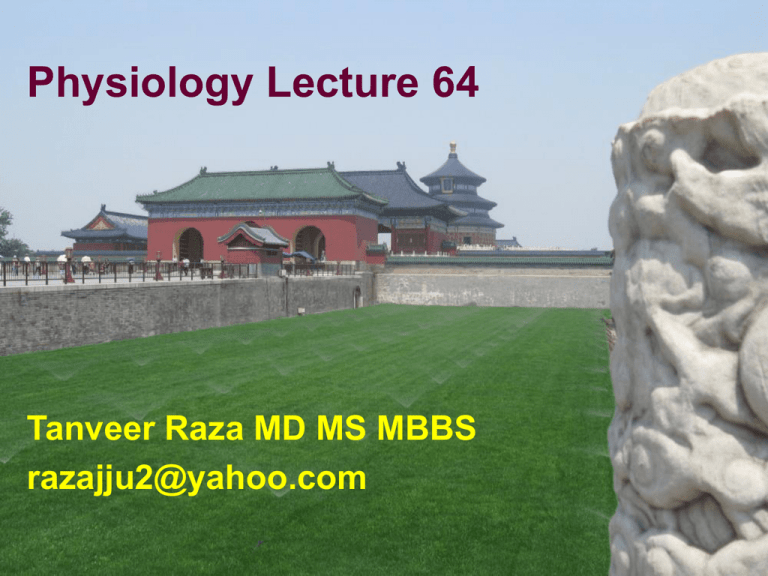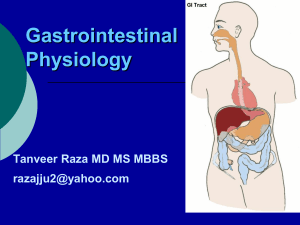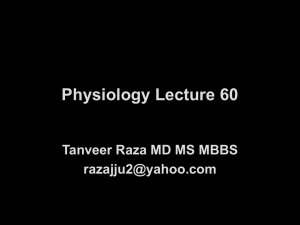Physiology Lecture 63
advertisement

Physiology Lecture 64 Tanveer Raza MD MS MBBS razajju2@yahoo.com Tanveer Raza MD MS MBBS razajju2@yahoo.com White Blood Cells • Pluripotential hematopoietic stem cells – CFU-S • CFU-E – Eryhtrocytes • CFU-GM – Granulocytes – Monocytes • CFU-M – Megakaryocytes (Platelets) – LSC • T Lymphocytes • B Lymphocytes Tanveer Raza MD MS MBBS razajju2@yahoo.com Genesis of WBC The different cells of the myelocyte series are 1, myeloblast; 2, promyelocyte; 3, megakaryocyte; 4, neutrophil myelocyte; 5, young neutrophil metamyelocyte; 6, "band" neutrophil metamyelocyte; 7, polymorphonuclear neutrophil; 8, eosinophil myelocyte; 9, eosinophil metamyelocyte; 10, polymorphonuclear eosinophil; 11, basophil myelocyte; 12, polymorphonuclear basophil; 1316, stages of monocyte formation Tanveer Raza MD MS MBBS razajju2@yahoo.com Tanveer Raza MD MS MBBS razajju2@yahoo.com White Blood Cells • Myelocytic Lineage – Production of Granulocyte and Monocytes – Begins with myeloblast – Formed in bone marrow • Lymphocytic lineage – Production of T and B lymphocytes – Begins with lymphoblast – Produced mainly in various lymphogenous tissues Tanveer Raza MD MS MBBS razajju2@yahoo.com White Blood Cells • Lymphogenous tissues – Lymph glands – Spleen – Thymus – Tonsils – Pockets of lymphoid tissue elsewhere in body • Bone marrow • Peyer's patches –Lymphogneous tissue underneath gut wall epithelium Tanveer Raza MD MS MBBS razajju2@yahoo.com White Blood Cells • WBC formed in bone marrow are stored until needed in the circulation – Normally, about three times WBC are stored in the marrow • a 6-day supply • Lymphocytes are mostly stored in the various lymphoid tissues Tanveer Raza MD MS MBBS razajju2@yahoo.com White Blood Cells • Megakaryocytes – Formed in the bone marrow – Megakaryocytes fragment in bone marrow – Smaller fragments are known as platelets (or thrombocytes) • Platelets then pass into the blood • Very important for blood clotting Tanveer Raza MD MS MBBS razajju2@yahoo.com Defence Against Infections • Neutrophils and macrophages comprise the professional phagocytes, are endowed with a unique capacity to engulf and thereby eliminate pathogens and cell debris – Neutrophils attack and destroy bacteria in circulating blood Tanveer Raza MD MS MBBS razajju2@yahoo.com Defence Against Infections • Tissue macrophages – Blood Monocytes • In blood are known as monocytes – Immature cells – Cannot fight infectious agents – When they enter the tissues, begin to swell and are called macrophages – Tissue Macrophages • Extremely capable of combating intratissue disease agents Tanveer Raza MD MS MBBS razajju2@yahoo.com Tanveer Raza MD MS MBBS razajju2@yahoo.com White Blood Cells • a.k.a. White Blood Corpuscles, WBC, Leukocytes • Normal count 4,000-11,000 cells/µL of blood – Average 7,000 (9,000) cells/µL of blood • Life span: Few hours to days Tanveer Raza MD MS MBBS razajju2@yahoo.com White Blood Cells • Differential Count – Neutrophils – Eosinophils – Basophils – Monocytes – Lymphocytes 62.0% (50-70%) 2.3% (1-4%) 0.4% (0-0.4%) 5.3% (2-8%) 30.0% (20-40%) Tanveer Raza MD MS MBBS razajju2@yahoo.com White Blood Cells • Life Span – Granulocytes • After being released from bone marrow – In blood 4 to 8 hours – In tissues 4 to 5 days where needed • During serious tissue infection, total life span shortened Tanveer Raza MD MS MBBS razajju2@yahoo.com White Blood Cells • Life Span – Monocytes • In blood 10 to 20 hours • In tissues, they become tissue Macrophages – Can live for months – Tissue macrophages provide continuing defense Tanveer Raza MD MS MBBS razajju2@yahoo.com White Blood Cells • Life Span – Lymphocytes • Continual circulation of lymphocytes – Lymphocytes enter circulation with lymph from the lymph nodes and other lymphoid tissue – After a few hours, they go out of blood and back into the tissues by diapedesis – Again re-enter lymph and return to blood • Life spans (weeks or months) depends on the body's need for these cells Tanveer Raza MD MS MBBS razajju2@yahoo.com White Blood Cells • Life Span – Platelets • In the blood are replaced about once every 10 days – About 30,000 platelets are formed each day for each ml/blood Tanveer Raza MD MS MBBS razajju2@yahoo.com White Blood Cells • Life Span – In bone marrow: • RBC:WBC=1:50 – In Circulation: • RBC:WBC=500:1 Tanveer Raza MD MS MBBS razajju2@yahoo.com White Blood Cells • Types – Granulocytes or Polymorphonuclear leukocytes • Polymorphonuclear Neutrophils • Polymorphonuclear Basophils • Polymorphonuclear Eosinophils – Agranulocytes or Mononuclear leukocytes • Lymphocytes • Monocytes • Plasma Cells Tanveer Raza MD MS MBBS razajju2@yahoo.com White Blood Cells • Function – Mobile units of the body's protective system • Phagocytosis – Granulocytes – Monocytes • Immune System – Plasma Cells – Lymphocytes Tanveer Raza MD MS MBBS razajju2@yahoo.com White Blood Cells: Diapedesis • Process by which Neutrophils and Monocytes come out of blood vessel wall – Pores of vessel wall are smaller than cells – Small portion of the cell squeezes through the pores Tanveer Raza MD MS MBBS razajju2@yahoo.com A, Endothelium (EC)-lined neovessel with diapedesis of macrophage Balakrishnan, K. R. et al. Circulation 2006;113:e41-e43 Copyright ©2006 American Heart Association White Blood Cells: Ameboid movement • Special type of movement by which Neutrophils and Macrophages move towards damaged tissues – Begins with protrusion of one end of cell (pseudopodium) – Remainder of cell moves towards pseudopodium Tanveer Raza MD MS MBBS razajju2@yahoo.com White Blood Cells: Chemotaxis • Movement towards a chemical substances – Seen in Neutrophil and Macrophages • Chemotactic substances – Bacterial or viral toxins – Degenerative products of the inflamed tissues – Several reaction products of the "complement complex" activated in inflamed tissues – Several reaction products caused by plasma clotting in the inflamed area, as well as other substances Tanveer Raza MD MS MBBS razajju2@yahoo.com White Blood Cells: Phagocytosis • Phagocytosis – Cellular ingestion of offending agent • Phagocytes is selective – Rough surface – Protective protein coating – Opsonin Tanveer Raza MD MS MBBS razajju2@yahoo.com White Blood Cells: Phagocytosis • Phagocytes is selective – Rough surface • Most natural structures in the tissues have smooth surfaces, which resist phagocytosis • Substances to be phagocytosed has a rough surface Tanveer Raza MD MS MBBS razajju2@yahoo.com White Blood Cells: Phagocytosis • Phagocytes is selective – Protective protein coating • Most natural substances of the body have protective protein coats that repel phagocytes • Most dead tissues and foreign particles have no protective coating Tanveer Raza MD MS MBBS razajju2@yahoo.com White Blood Cells: Phagocytosis • Phagocytes is selective – Opsonin • Antibodies adhere to the bacterial membranes making it more susceptible to phagocytosis Tanveer Raza MD MS MBBS razajju2@yahoo.com Lee at al. 2003 Phagocytosis by neutrophils. Time-lapse sequence of Fcc receptormediated phagocytosis. Human neutrophils were exposed to IgGopsonized latex beads, and differential interference images were acquired at the indicated times (in minutes). Within several minutes, a neutrophil extends pseudopodia and engulfs several particles in succession. Tanveer Raza MD MS MBBS razajju2@yahoo.com White Blood Cells: Phagocytosis • 3 steps – Recognition and attachment – Engulfment – Killing/degradataion Tanveer Raza MD MS MBBS razajju2@yahoo.com WBC: Neutrophils • Most common WBC • Professional Phagocytes – First to arrive at infection site – Ingests bacteria, virus particles, fungi or protozoa • Multilobed nuclei – Nuclei may have 2-5 lobes • Granules – Fine, uniformly distributed Tanveer Raza MD MS MBBS razajju2@yahoo.com Neutrophilic and Eosinophilic Neutrophils, Peripheral blood smear, Wright-Giemsa stain, 1000x Tanveer Raza MD MS MBBS razajju2@yahoo.com WBC: Neutrophils • Function – Phagocytosis • After attaching to particle, projects pseudopodia engulfing particle and forming a chamber • Chamber is invaginated into cytoplasmic cavity forming phagocytic vesicle (phagosome) – Digestion of Ingested particle – Release chemotactic factor for Macrophages Tanveer Raza MD MS MBBS razajju2@yahoo.com WBC: Neutrophils • Function – Phagocytosis – Digestion of Ingested particle • Lysosomes and other cytoplasmic granules fuse with phagosome • Dumping many digestive enzymes and bactericidal agents into the vesicle – Lysosomes contain proteolytic enzymes that digest bacteria and other foreign protein matter – Release chemotactic factor for Macrophages Tanveer Raza MD MS MBBS razajju2@yahoo.com WBC: Neutrophils • Function – Neutrophils and Macrophages can Kill Bacteria • Contains bactericidal agents that kill most bacteria even when lysosomal enzymes fail to digest them – Especially important, because some bacteria have protective coats or other factors that prevent their destruction by digestive enzymes Tanveer Raza MD MS MBBS razajju2@yahoo.com WBC: Neutrophils • Function – Bactericidal agents • Powerful oxidizing agents – lethal to most bacteria, even in small quantities – Formed by enzymes in the membrane of the phagosome or by a special organelle called the peroxisome – superoxide (O2-) – hydrogen peroxide (H2O2) – hydroxyl ions (-OH-) Tanveer Raza MD MS MBBS razajju2@yahoo.com WBC: Neutrophils • Function – Bactericidal agents • Lysosomal enzymes – Myeloperoxidase – catalyzes the reaction between H2O2 and chloride ions to form HOCl, which is exceedingly bactericidal. Tanveer Raza MD MS MBBS razajju2@yahoo.com WBC: Neutrophils • Function – Bactericidal agents • Some bacteria, ex. tuberculosis bacillus, have coats resistant to lysosomal digestion and secrete substances that partially resist the killing effects of the neutrophils and macrophages These bacteria are responsible for many of the chronic diseases (tuberculosis) Tanveer Raza MD MS MBBS razajju2@yahoo.com WBC: Macrophages • Monocytes enter blood from bone marrow and circulate in blood for about 72 hours • They then enter tissues and become tissue Macrophages Tanveer Raza MD MS MBBS razajju2@yahoo.com WBC: Macrophages • Phagocytosis by Macrophages – Much more powerful phagocytes than neutrophils – Can phagocytoze more bacteria • Engulf much larger particles • even whole RBCs, malarial parasites Tanveer Raza MD MS MBBS razajju2@yahoo.com Reticuloendothelial System Tanveer Raza MD MS MBBS razajju2@yahoo.com Reticuloendothelial System • a.k.a. – Monocyte-Macrophage Cell System – Mononuclear Phagocytic System (MPS) • The total combination of monocytes, mobile macrophages, fixed tissue macrophages, and a few specialized endothelial cells in the bone marrow, spleen, and lymph nodes is called the reticuloendothelial system • All or almost all these cells originate from monocytic stem cells Tanveer Raza MD MS MBBS razajju2@yahoo.com Reticuloendothelial System • Tissue Macrophages – Remains attached for months or even years until called to perform specific local protective functions – When appropriately stimulated, they become mobile macrophages • Have similar functions as mobile macrophages Tanveer Raza MD MS MBBS razajju2@yahoo.com Reticuloendothelial System • Tissue Macrophages – Histiocytes • Tissue Macrophages in the Skin and Subcutaneous Tissues – Macrophages in the Lymph Nodes – Alveolar Macrophages in the Lungs – Kupffer Cells • Macrophages in the Liver Sinusoids – Macrophages of the Spleen and Bone Marrow – Microglia in brain Tanveer Raza MD MS MBBS razajju2@yahoo.com Reticuloendothelial System • Histiocytes – Tissue macrophages in Skin and Subcutaneous Tissues – Broken is susceptible to infectious agents – Histiocytes protect against infection in a subcutaneous tissue and local inflammation ensues Tanveer Raza MD MS MBBS razajju2@yahoo.com Reticuloendothelial System • Macrophages in the Lymph Nodes – Particles not destroyed in tissues enter lymph and flow to lymph nodes located – Particles are trapped in these nodes in a meshwork of sinuses lined by tissue macrophages • Large numbers of macrophages line lymph sinuses Tanveer Raza MD MS MBBS razajju2@yahoo.com Functional diagram of a lymph node. Tanveer Raza MD MS MBBS razajju2@yahoo.com Reticuloendothelial System • Alveolar Macrophages in the Lungs – Large numbers of tissue macrophages are present in alveolar walls – Giant Cell • If particle not digestible, macrophages often form a "giant cell" capsule around particle until such time-if ever-that it can be slowly dissolved • Frequently formed around tuberculosis bacilli, silica dust particles and carbon particles Tanveer Raza MD MS MBBS razajju2@yahoo.com Reticuloendothelial System • Kupffer Cells – Macrophages (Kupffer Cells) in the Liver Sinusoids – Bacteria invading through GIT – Portal blood from GIT passes through liver sinusoids before entering general circulation Tanveer Raza MD MS MBBS razajju2@yahoo.com Kupffer cells lining the liver sinusoids, showing phagocytosis of India ink particles into the cytoplasm of the Kupffer cells. Tanveer Raza MD MS MBBS razajju2@yahoo.com Reticuloendothelial System • Macrophages of Spleen and Bone Marrow – When invading organism enters the general circulation – Spleen is similar to the lymph nodes • Blood flows instead of lymph Tanveer Raza MD MS MBBS razajju2@yahoo.com Functional structures of the spleen. Tanveer Raza MD MS MBBS razajju2@yahoo.com Inflammatory response • Inflammation – Vascular response to injury – Major local manifestations of acute inflammation • Vascular dilation and increased blood flow (causing erythema and warmth) • Extravasation and deposition of plasma fluid and proteins (edema) • Leukocyte emigration and accumulation in the site of injury Tanveer Raza MD MS MBBS razajju2@yahoo.com Inflammatory response • Some of the many tissue products that cause these reactions are – Histamine – Bradykinin – Serotonin – Prostaglandins – Several different reaction products of complement system – Reaction products of blood clotting system – Lymphokines • Substances that are released by sensitized T cells Tanveer Raza MD MS MBBS razajju2@yahoo.com Inflammatory response • Several of these substances strongly activate the macrophage system – Macrophages devour the destroyed tissues. – Sometimes the macrophages further injure the still-living tissue cells Tanveer Raza MD MS MBBS razajju2@yahoo.com Inflammatory response • First Line of Defense Against Infection – Tissue Macrophage • Second Line of Defense – Neutrophil Invasion of the Inflamed Area • Third Line of Defense – Second Macrophage Invasion of Inflamed Tissue • Fourth Line of Defense – Increased Production of Granulocytes and Monocytes by the Bone Marrow Tanveer Raza MD MS MBBS razajju2@yahoo.com Inflammatory response: First Line of Defense against infection • Within minutes after inflammation begins, the macrophages already present in the tissues, immediately begin their phagocytic actions Tanveer Raza MD MS MBBS razajju2@yahoo.com Inflammatory response: Second Line of Defense against infection • Neutrophil Invasion of the Inflamed Area – Within the first hour or so after inflammation begins, large numbers of neutrophils begin to invade the inflamed area from the blood – Neutrophilia • Acute Increase in Number of Neutrophils in the Blood Tanveer Raza MD MS MBBS razajju2@yahoo.com Inflammatory response: Third Line of Defense against infection • Second Macrophage Invasion into the Inflamed Tissue – Along with the invasion of neutrophils, monocytes from the blood enter the inflamed tissue and enlarge to become macrophages. Tanveer Raza MD MS MBBS razajju2@yahoo.com Inflammatory response: Fourth Line of Defense against infection • Increased Production of Granulocytes and Monocytes by the Bone Marrow – It takes 3 to 4 days before newly formed granulocytes and monocytes reach the stage of leaving the bone marrow Tanveer Raza MD MS MBBS razajju2@yahoo.com Inflammatory response • Feedback control of Macrophage & Neutrophil responses – Factors which play dominant role • Tumor necrosis factor (TNF) • Interleukin-1 (IL-1) • Granulocyte-monocyte colony-stimulating factor (GM-CSF) • Granulocyte colony-stimulating factor (G-CSF) • Monocyte colony-stimulating factor (M-CSF) – These factors are formed by activated macrophage cells in inflamed tissues and alsoin smaller quantities by other inflamed tissue cells Tanveer Raza MD MS MBBS razajju2@yahoo.com Thank You









